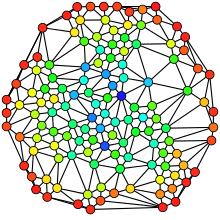|
Brandes' algorithm
In network theory, Brandes' algorithm is an algorithm for calculating the betweenness centrality of vertices in a graph. The algorithm was first published in 2001 by Ulrik Brandes.[1] Betweenness centrality, along with other measures of centrality, is an important measure in many real-world networks, such as social networks and computer networks.[2][3][4] DefinitionsThere are several metrics for the centrality of a node, one such metric being the betweenness centrality.[5] For a node in a connected graph, the betweenness centrality is defined as:[6][7] where is the total number of shortest paths from node to node , and is the number of these paths which pass through . For an unweighted graph, the length of a path is considered to be the number of edges it contains. By convention, whenever , since the only path is the empty path. Also, if is either or , since shortest paths do not pass through their endpoints. The quantity is known as the pair dependency of on , and represents the proportion of the shortest – paths which travel via . The betweenness centrality is simply the sum of the pair dependencies over all pairs. As well as the pair dependency, it is also useful to define the (single) dependency on , with respect to a particular vertex :
with which, we can obtain the concise formulation
AlgorithmBrandes' algorithm calculates the betweenness centrality of all nodes in a graph. For every vertex , there are two stages. Single-source shortest pathThe number of shortest paths between and every vertex is calculated using breadth-first search. The breadth-first search starts at , and the shortest distance of each vertex from is recorded, dividing the graph into discrete layers. Additionally, each vertex keeps track of the set of vertices which in the preceding layer which point to it, . Described in set-builder notation, it can be written as:
This lends itself to a simple iterative formula for :
which essentially states that, if is at depth , then any shortest path at depth extended by a single edge to becomes a shortest path to . BackpropagationBrandes proved the following recursive formula for vertex dependencies:[1]
where the sum is taken over all vertices that are one edge further away from than . This lemma eliminates the need to explicitly sum all of the pair dependencies. Using this formula, the single dependency of on a vertex at depth is determined by the layer at depth . Furthermore, the order of summation is irrelevant, which allows for a bottom up approach starting at the deepest layer. It turns out that the dependencies of on all other vertices can be computed in time. During the breadth-first search, the order in which vertices are visited is logged in a stack data structure. The backpropagation step then repeatedly pops off vertices, which are naturally sorted by their distance from , descending. For each popped node , we iterate over its predecessors : the contribution of towards is added, that is,
Crucially, every layer propagates its dependencies completely, before moving to the layer with lower depth, due to the nature of breadth-first search. Once the propagation reaches back to , every vertex now contains . These can simply be added to , since
After iterations of single-source shortest path and backpropagation, each contains the betweenness centrality for . PseudocodeThe following pseudocode illustrates Brandes' algorithm on an unweighted directed graph.[8] algorithm Brandes(Graph) is
for each u in Graph.Vertices do
CB[u] ← 0
for each s in Graph.Vertices do
for each v in Graph.Vertices do
δ[v] ← 0 // Single dependency of s on v
prev[v] ← empty list // Immediate predecessors of v during BFS
σ[v] ← 0 // Number of shortest paths from s to v (s implied)
dist[v] ← null // No paths are known initially,
σ[s] ← 1 // except the start vertex
dist[s] ← 0
Q ← queue containing only s // Breadth-first search
S ← empty stack // Record the order in which vertices are visited
// Single-source shortest paths
while Q is not empty do
u ← Q.dequeue()
S.push(u)
for each v in Graph.Neighbours[u] do
if dist[v] = null then
dist[v] ← dist[u] + 1
Q.enqueue(v)
if dist[v] = dist[u] + 1 then
σ[v] ← σ[v] + σ[u]
prev[v].append(u)
// Backpropagation of dependencies
while S is not empty do
v ← S.pop()
for each u in prev[v] do
δ[u] ← δ[u] + σ[u] / σ[v] * (1 + δ[v])
if u ≠ s then
CB[v] ← CB[v] + δ[v] // Halved for undirected graphs
return CB
Running timeThe running time of the algorithm is expressed in terms of the number of vertices and the number of edges . For each vertex , we run breadth-first search, which takes time. Since the graph is connected, the component subsumes the term, since the number of edges is at least . In the backpropagation stage, every vertex is popped off the stack, and its predecessors are iterated over. However, since each predecessor entry corresponds to an edge in the graph, this stage is also bounded by . The overall running time of the algorithm is therefore , an improvement on the time bounds achieved by prior algorithms.[1] In addition, Brandes' algorithm improves on the space complexity of naive algorithms, which typically require space. Brandes' algorithm only stores at most predecessors, along with data for each vertex, making its extra space complexity VariantsThe algorithm can be generalised to weighted graphs by using Dijkstra's algorithm instead of breadth-first search. When operating on undirected graphs, the betweenness centrality may be divided by 2, to avoid double counting each path's reversed counterpart. Variants also exist to calculate different measures of centrality, including betweenness with paths at most length , edge betweenness, load betweenness, and stress betweenness.[8] References
|
||||||||||
Portal di Ensiklopedia Dunia






































